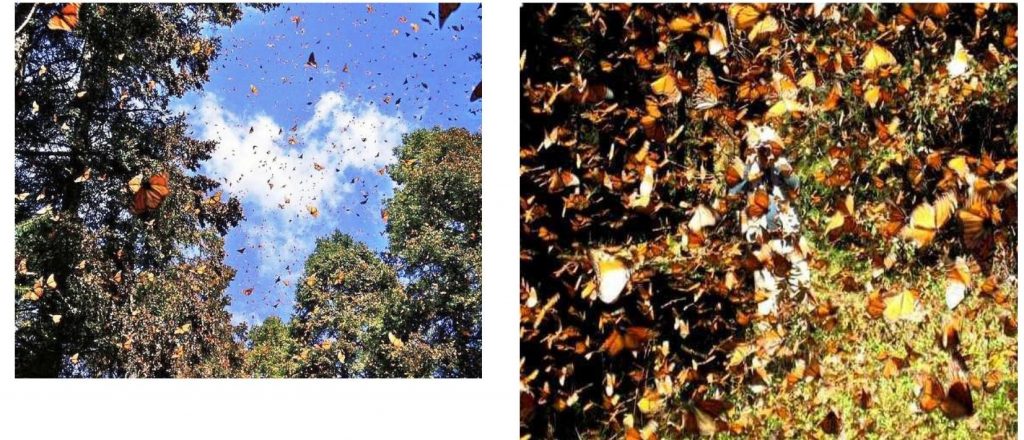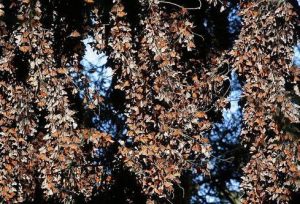By Suzanne A. Marshall from the June 2014 Edition
Since childhood I have been enthralled with these beautiful fluttering creatures, at that time, completely unaware of how truly remarkable they were. I was simply engaged by their remarkable beauty and flight. We had learned in school about their basic metamorphosis from egg to caterpillar then the chrysalis to butterfly. I even began watching where I was walking to make sure I didn’t step on one and would look for the striped caterpillars on the branches of trees. Most commonly I would recognize the Monarchs, with their very recognizable yellowish-orange color with black and white details.

Below is a photo taken of me twenty plus years ago at the Devonian Gardens Butterfly House in central Alberta outside Edmonton. It just felt like ‘karma’ that something I loved so much would choose to land on my dangly wooden earring!

Eventually decades later, I began to hear about the Monarch migrations all the way from Canada into the heart of Mexico. How could such tiny creatures endure the distances of over 2000 miles to winter and begin another journey heading north in the spring? Most intriguing for me was the obvious question of such a fragile species living long enough to survive such a journey and then return. Well, this question was answered very recently when by chance we tuned in to one of our favorite TV channels (NOVA – The Incredible Journey of the Butterflies). The answers are simply mind-boggling. Shot from a butterfly’s point of view using helicopters, ultralights and hot- air balloons for aerial views, I highly recommend this amazing documentary production.

Leaving Canada and northern US areas in late summer, having feasted on milkweed, the Monarchs take flight triggered by some unknown signal on a two month journey. They fly over the Great Lakes, fields, forests, cities, deserts and mountains to congregate in late October in a high altitude region of Mexico in the state of Michoacan. It is a tremendous spectacle each year when as many as 60 million to one billion Monarch butterflies arrive to cluster in small areas of the Reserve de la Biosfera Mariposa Monarca (Monarch Butterfly Biosphere Reserve) a national protected area and nature preserve that covers more than 200 square miles. No one knows how they all find their way to this exact location. It remains a mystery for now. There are several areas of the reserve that are open to the public November through March.

Making their winter homes on the trunks and tops of trees, the arrival of the Monarchs coincides with one of the most important Mexican holidays named Dia de los Muertos (Day of the Dead). During this annual holiday, feasts, celebrations and elaborate offerings honor a local legend that interprets the arrival of the Monarchs as the souls of the deceased returning to earth.
The butterflies will spend the next five months clustering together covering the trunks and branches of the trees in a glorious blanket of orange and black. The clusters are so voluminous that the branches bend and sometimes snap from the sheer weight. The clustering allows the butterflies to conserve heat and survive the cool nighttime temperatures common at this altitude. In February and March the butterflies begin their mating rituals as they begin to ready for the return migration north. And here is where the story begins to take a remarkable turn.
In answer to my own question, ‘how do they live so long?’ I have learned that the return to northern areas of the U.S. and Canada takes four generations. Once the Monarchs leave Mexico they begin the journey north where part of the way in March and April they lay their eggs on milkweed plants then die soon thereafter. After about four days the eggs begin to hatch and the new caterpillars munch on the milkweed for a few weeks until maturity at which time they begin the transformation of making a silk chrysalis.

Within the chrysalis a rapid and remarkable change takes place when the body parts of the caterpillar undergo metamorphosis and become the beautiful butterflies that emerge. These butterflies will have a shorter life of two to six weeks. After laying their eggs, ‘generation one’ will die and their eggs will hatch and now become ‘generation two’.
In May and June ‘generation two’ moves further north and repeats the cycle producing the ‘third generation’ which is born in July and August. This generation will repeat the same two to six week cycle moving further north again and giving birth to ‘generation four’
‘Generation four’ of the Monarchs is different. Born in September and October, the reproduction cycle remains the same, however, this generation has reached the northern destinations and will live for six to eight months. They will repeat the same migration that took place four generations ago and be mysteriously called to migrate back to Michoacan, Mexico where another four generations will repeat the same journey back the following year. How spectacular
is nature!
This is one of those true stories that helps us all to understand the incredible complexity of life among all species of animals large and small. I have added this destination to my ‘bucket list’ and because I enjoy fabulous winters in my Mexican ‘second’ home, that journey will take place sooner than later. I can hardly wait.
(Sources:NOVA-The Incredible Journey of the Butterflies;Wikipedia.org;
www.Monarch Butterfly.com;www.visitmexico.com)
Download the full edition or view it online
—
Suzanne A. Marshall hails from western Canada and has been living the good life in Manzanillo over the past 8 years. She is a wife, mom and grandma. She is retired from executive business management where her writing skills focused on bureaucratic policy, marketing and business newsletters. Now she shares the fun and joy of writing about everyday life experiences in beautiful Manzanillo, Mexico, the country, its people, the places and the events.




You must be logged in to post a comment.